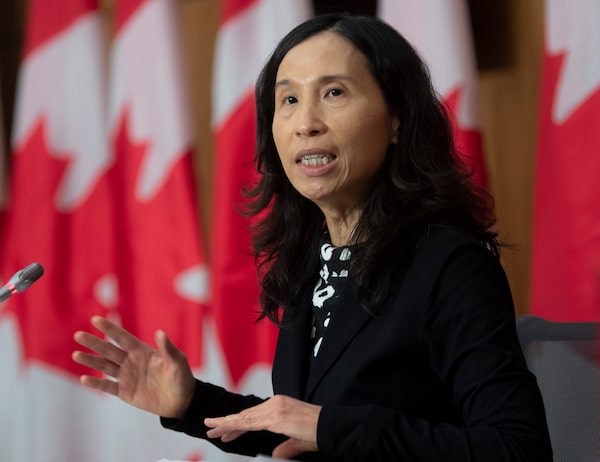
Dr. Theresa Tam, Canada's chief public health officer, responds to a question during a news conference in Ottawa, on Oct. 28, 2020.Adrian Wyld/The Canadian Press
Canada’s top doctor has warned that the government must correct its “boom and bust” approach to preparing for major outbreaks, which left the country ill-equipped for COVID-19 and eroded key safety systems such as the pandemic early warning unit.
Chief Public Health Officer Theresa Tam acknowledged on Wednesday that the government needs to correct some of the mistakes made before the outbreak, when the threat of a pandemic may have seemed remote. These include the decision to scale back its pandemic intelligence system, known as the Global Public Health Intelligence Network, or GPHIN. The highly specialized unit of the Public Health Agency of Canada was a cornerstone of Canada’s preparedness strategy until it was silenced last year amid shifting priorities and resources.
“We need to continue to remember this moment – this moment in history – and why we need those capacities,” Dr. Tam said as she delivered her annual report on the state of public health in Canada, which was tabled in the House of Commons.
“COVID-19 has catalyzed those discussions. GPHIN is something that we should be proud of, we need to think about what the next iteration of GPHIN looks like.”
What happened with Canada’s pandemic alert system? The GPHIN controversy explained
Ending Canada’s pandemic alert system was a mistake, internal government e-mails show
GPHIN was created in the 1990s to provide advance warning, detection and ongoing surveillance of global health threats, particularly in cases where foreign governments might try to hide a problem. Its purpose was to relay crucial information to decision makers and inject urgency into government responses.
Speaking a day after the Canadian death toll for COVID-19 surpassed 10,000 people, and with the country in the midst of a surge in new cases, Dr. Tam said a new strategy is needed once this pandemic subsides.
“One thing that is difficult for Public Health [to do] is to advocate for sustained investments and avoid this boom and bust panic,” Dr. Tam said.
She also said the pandemic exposed weaknesses in the national emergency stockpile of medical equipment, and the ability to protect vulnerable populations – such as aging and homeless people.
Public health experts, including doctors and epidemiologists working inside the agency, say Canada’s public health system was allowed to erode over the past decade through funding cuts and dwindling support for scientific programs.
A Globe and Mail investigation in July revealed the federal government made a crucial decision in 2018 that shifted GPHIN’s resources to areas that did not involve pandemic preparedness and reassigned some of its scientists. That hurt Canada’s ability to respond to a major outbreak.
GPHIN’s pandemic early warning system, which was a key part of global outbreak surveillance among Canada’s allies, and provided the World Health Organization with one-fifth of its intelligence-gathering on health threats around the world, was also silenced.
Dr. Tam called GPHIN a “real-life example” of Canadian “technology, algorithms and expertise” that may have been underestimated within the government.
“But if you asked international partners, the World Health Organization, they’ll say that was the forerunner of health intelligence," Dr. Tam said, adding the government is now going to “relook" at GPHIN to see how it can be strengthened.
The fallout over GPHIN has shaken the federal public health agency. Its president and a vice-president have departed amid the controversy, and two investigations have been launched into the matter. The Auditor-General is looking into the situation, and the Health Minister has ordered an independent federal review.
Dr. Tam said there should a fundamental look at how the national emergency stockpile is managed, and how the government can scale up quickly in the face of another major outbreak.
“As a society as a whole, we need to think of prevention more,” Dr. Tam said. "How do we make the most effective case for public health going forward and using the lessons learned from this pandemic?”
The annual report also calls for sweeping structural changes to how Canada approaches public health, with more collaboration between levels of government, better data collection and sharing, and more awareness of the social and economic impacts of a pandemic.
“It can’t be Public Health and the health sector planning, and then hoping other people will listen,” Dr. Tam said.
Between health crises, there is a tendency to become complacent, the report warns. This affects how Canada readies itself for a future threat. After the 2003 SARS crisis, the federal government created the public health agency to prepare for another deadly outbreak, but that urgency waned, and investments dropped. A key lesson from COVID-19 will be to avoid that same outcome, Dr. Tam suggested, arguing that prevention is much less costly than treatment.
“Public Health is invisible when there are no cases, when we’ve done our job,” Dr. Tam said. "So it’s very difficult to advocate for public health capacity when you’ve prevented things from happening. But that’s what we must do.”
Sign up for the Coronavirus Update newsletter to read the day’s essential coronavirus news, features and explainers written by Globe reporters and editors.